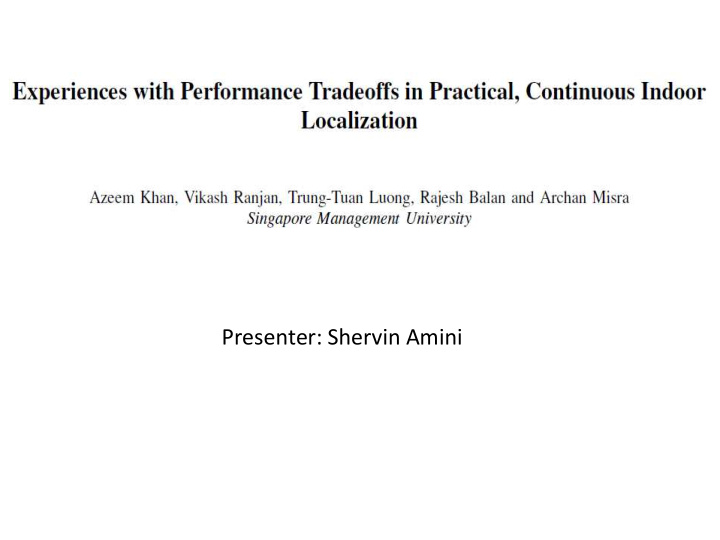



Presenter: Shervin Amini
Motivation • Indoor localization of consumer mobile devices • Previous works focuses on accuracy of the localization • Less work on scalability and energy consumption • Challenge: accuracy and energy consumption
Concepts • Indoor localization is based on Wi-Fi-based positioning system • Wi-Fi positioning uses access points (AP) • Any localization technique measures the intensity of the signals (received signal strength) • RSSI from different APs form radio map for a given area (probability of RSSI values for a location/ fingerprinting) • Comparing new RSSI values against fingerprint and estimate the location Fingerprint map of a playground wrt. a particular landmark
System setup • Using two dominant smart phone OS – Android on Samsung Galaxy S3 phone – iOS on iPhone 4 (does not have open API to scan Wi-Fi data) • Public indoor locations – Mall (high visitor load on evenings and weekends) – SIS(campus building), high load during class times
Contributions • Localization strategy for Android and iOS – Combining Wi-Fi fingerprinting and motion estimation with Viterbi algorithm – Finding temporal sequence of locations • Building characteristics (density, building structure) affects the accuracy
Wi-Fi Data Collections • Offline collection of RF at known landmaks (AP i , signature AP i ) • Generating fingerprint maps – Android: using custom application for scanning Wi-Fi access points. <timeStamp, RSSI, AP ID> – iOS: reverse fingerprinting A server(controller) is responsible for measuring the signal to noise ratio (SNR) sent form iPhone
Localization Process Most likely sequence of (temporal)locations accelerometer compass (movement distance) (angular movement)
Fingerprinting on Android AP Fingerprint(iOS) , [ , ] L AP SNR i i AP i , [ , ] L AP SNR 1 1 i i AP i 1 landmark AP Fingerprint (offline phase) Euclidean distance of Selecting top K m(t) with fingerprint nearest landmarks Online measurement
Path Estimation (Viterbi) ( ( ) ( )) ( ( )) ( ( ) | ( )) * ( ( )) P L t L t P L t P L t L t P L t 1 1 1 m i n i m i n i m i n i
Indoor localization accuracy • On Android: having more number of APs does NOT lead to better accuracy (redundant measurements) • On iOS: Having more number of APs helps for better location estimation(SNR queries are sent every 3 to 4 minues)
Density(impact on localization accuracy) Higher densities leads to less movement Less accuracy
Energy versus Accuracy • Experiments done on Samsung SII phone (over 20 minutes) Most of the energy is consumed by inertial sensors (237 mW) My final project theme: improving the energy consumption while maintaining the accuracy/performance
Critique • Strength – Using state-of-the-art mobile technologies for tracking large number of mobile devices • Challenges – Proposed localization technology is not universal for individual indoor space – Localization techniques do not support continuous location tracking
Choosing Landmarks(backup)
Recommend
More recommend